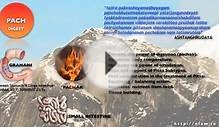
|
Have you ever wondered what actually accounts for differences in people? Why are some people hyperactive and fast moving, while others exude grace and stillness? Why can some people eat a five-course meal with ease, while others can barely finish a salad? Why are some people inherently joyous, while others carry the weight of the world on their shoulders? Modern genetics offers some insight, but what about the characteristics and idiosyncrasies that make every person unique? Ayurveda answers all of these questions with the Three Doshas: Vata, Pitta, and Kapha. The doshas are biological energies found throughout the human body and mind. They govern all physical and mental processes and provide every living being with an individual blueprint for health and fulfillment. The doshas derive from the Five Elements and their related properties. Vata is composed of Space and Air, Pitta of Fire and Water, and Kapha of Earth and Water. |
| A person with a predominantly Vata constitution will have physical and mental qualities that reflect the elemental qualities of Space and Air. That is why Vata types are commonly quick thinking, thin, and fast moving. A Pitta type, on the other hand, will have qualities reflective of Fire and Water, such as a fiery personality and oily skin. A Kapha type will typically have a solid bodily frame and calm temperament, reflecting the underlying elements of Earth and Water. While one dosha predominates in most individuals, a second dosha typically has a strong influence. This is referred to as a dual-doshic constitution. To begin figuring out your own unique constitution, click here for a dosha self-test.
The doshas are dynamic energies that constantly change in response to our actions, thoughts, emotions, the foods we eat, the seasons, and any other sensory inputs that feed our mind and body. When we live into the fulfillment of our individual natures, we naturally make lifestyle and dietary decisions that foster balance within our doshas. When we live against our intrinsic natures, we support unhealthy patterns that lead to physical and mental imbalances. If the proportion of doshas in your current state is close to your birth constitution, then your health will be vibrant. A divergence between these states, however, indicates a state of imbalance. Vikruti is the term used to describe this imbalanced deviation away from prakruti. In total, there are three primary doshic states: Balanced: All three doshas are present in their natural proportions; also referred to as “equilibrium.”
Of the three states, the increased or aggravated state leads to the greatest number of imbalances. Such imbalances can arise from any number of influences, including following a dosha-aggravating diet or, more generally, carrying too much stress in life. You can initiate a restoration of balance, however, when you begin to understand both your unique constitutional make-up and how to harmonize your internal environment and its needs with the external world. We are most susceptible to imbalances related to our predominant dosha. If you’re a Pitta type, for example, you may experience heartburn (a common Pitta disorder) after eating spicy foods. The key to remember is that like increases like, while opposites create balance. By simply choosing cooling or more alkalizing foods, you can avoid heartburn, while also supporting your underlying make-up. Ayurveda offers specifically tailored recommendations for every individual, ranging from general lifestyle changes to the treatment of dis-ease (literally, an imbalance within our natural state of “ease”). For this reason, Ayurveda can truly be called a system of individualized health care, something remarkably different from the Western model’s “one-pill for all” approach. Since the doshas are used to detect imbalances before the manifestation of dis-ease, Ayurveda is also a complete system of preventative medicine. |
| Vata derives from the elements of Space and Air and translates as “wind” or “that which moves things.” It is the energy of movement and the force governing all biological activity. Vata is often called the “King of the Doshas, ” since it governs the body’s greater life force and gives motion to Pitta and Kapha.
Just as the wind in balance provides movement and expression to the natural world, the balanced Vata individual is active, creative, and gifted with a natural ability to express and communicate. When the wind in a Vata type rages like a hurricane, negative qualities quickly overshadow these positive attributes. Common signs of Vata imbalance include anxiety and bodily disorders related to dryness, such as dry skin and constipation. The qualities of Vata are dry, rough, light, cold, subtle, and mobile. A Vata individual will display physical and mental characteristics that reflect these qualities in both a balanced and an imbalanced state. The main locations of Vata in the body are the colon, thighs, bones, joints, ears, skin, brain, and nerve tissues. Physiologically, Vata governs anything related to movement, such as breathing, talking, nerve impulses, movements in the muscles and tissues, circulation, assimilation of food, elimination, urination, and menstruation. Psychologically, Vata governs... |
RELATED VIDEO












